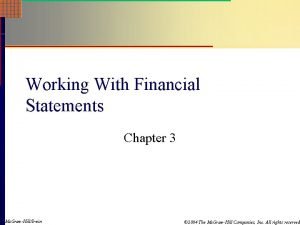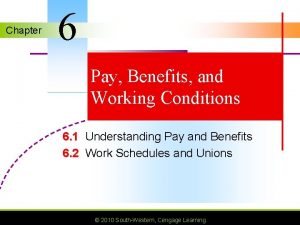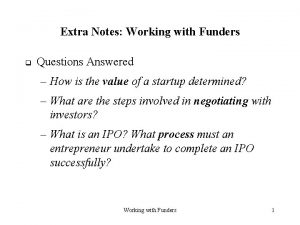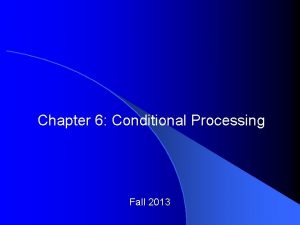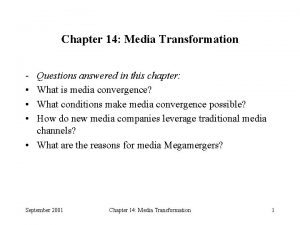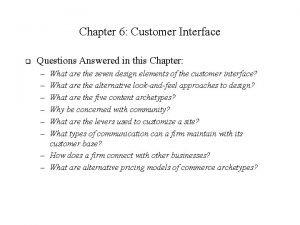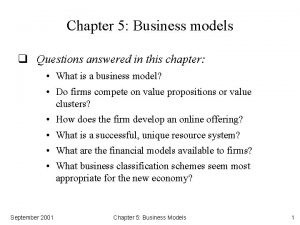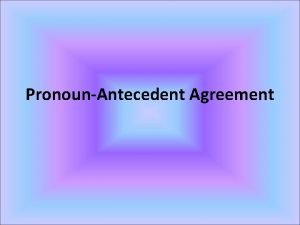Chapter 13 Working with Funders q Questions Answered




































- Slides: 36

Chapter 13: Working with Funders q Questions Answered in this Chapter – What are the major sources of equity financing, and how do these sources differ from one another? – How is the value of a startup determined? – What are the steps involved in negotiating with investors? – What is an IPO? What process must an entrepreneur undertake to complete an IPO successfully? September 2001 Ch 13: Working with Funders 1

Introduction q q Entrepreneurs must raise financial capital, protect the company from bad deals and follow through to a liquidity event Funding Considerations – – – Equity Financing Valuation Negotiations Exit (The Path to Liquidity) Future of Capital Markets September 2001 Ch 13: Working with Funders 2

September 2001 Ch 13: Working with Funders 3

September 2001 Ch 13: Working with Funders 4

September 2001 Ch 13: Working with Funders 5

Equity Financing q Bootstrapping – Bootstrapping is the act of using personal resources to get the business off the ground – Guiding Principles when bootstrapping • Get operational as soon as possible • Take on cash-generating projects, even if they are not in line with the written strategy • Go the extra mile to satisfy customers • Get comfortable with being cheap, but do not skimp on essentials to the business • Establish a relationship with a bank as soon as possible September 2001 Ch 13: Working with Funders 6

Equity Financing (Cont’d) q Angels – Angels are wealthy individuals who invest their own capital in startup companies they find potentially lucrative – Angels close the gap between bootstrapping and Venture Capital (VC) firms – Pros & Cons of Angel financing • Pros – Flexible exit strategy – Favorable terms sheet – Improved valuation before approaching VC • Cons – Possible last-minute backing-out of deals – Poorly structured agreements – Relatively small investment (sufficient for proof of concept, but not for mass-deployment) September 2001 Ch 13: Working with Funders 7

Equity Financing (Cont’d) q Venture Capital (VC) Community – VCs are in the business of finding companies with the potential for great growth and great economic return – Key Considerations • VC funds are organized as limited partnerships looking for long-term (5 -10 years) investments • VC firms make money through a combination of profits on investment and fund management fees • VC funds are created by a group of investors with a specific strategy for investment. The pool of money in the fund is fixed • The majority of VC investments are in companies that have entered an expansion phase • In the past few years, VC funds went largely to startup companies. The recent trend, however, has been to return to more traditional investments in stronger companies September 2001 Ch 13: Working with Funders 8

September 2001 Ch 13: Working with Funders 9

September 2001 Ch 13: Working with Funders 10

September 2001 Ch 13: Working with Funders 11

September 2001 Ch 13: Working with Funders 12

September 2001 Ch 13: Working with Funders 13

September 2001 Ch 13: Working with Funders 14

September 2001 Ch 13: Working with Funders 15

Valuation q q Valuation is the art/science of trying to determine the worth of a company Methods used in valuing a company – The Comparables Method • Determine the worth of a company by comparing it to other similar companies • The companies should be similar with respect to industry focus, income statement ratios, location, relations with suppliers, customer base, potential growth, growth rate and capital structure • This method assumes that similar companies exist and that the information for comparison is available September 2001 Ch 13: Working with Funders 16

Valuation (Cont’d) – The Financial Performance Method • Uses a company’s earnings (or potential earnings) to project future cash flows and applies a discount rate to determine the Present Value (PV) of those cash flows • The Discounted Cash Flow (DCF) is determined from – Proforma Income Statements – Projections about the company’s future income statements are made based on growth assumptions for cost and revenues – Free Cash Flow – The amount of cash the company will have at its disposal is estimated based on the proforma income statement – Terminal Value – The expected value of the company at the end of the projected period is estimated. A discount rate is then applied to this value to estimate the present value of the company September 2001 Ch 13: Working with Funders 17

September 2001 Ch 13: Working with Funders 18

Valuation (Cont’d) – The Venture Capital Method • VC’s use a hybrid valuation method, looking at both comparables and free cash flows • To compensate for their high risk investments, VC’s apply a very large discount rate to estimate the company’s present value • To compensate for future dilution, VC’s require a higher percentage ownership (for a given investment) based on an estimated retention ratio • This valuation method is necessarily subjective – The Asset Valuation Method • The company’s worth is determined from its current assets • Because the majority of their assets are intangible, this method is generally not used for startups in the e-commerce industry September 2001 Ch 13: Working with Funders 19

September 2001 Ch 13: Working with Funders 20

Negotiations q Principles for Entrepreneurs – Investors want to know two things: What is the opportunity and why is this management team the best to pull it off – Guidelines for pitching an investment opportunity • Know the audience • Keep the presentation concise • Talk about the management team q Term Sheet – A Term Sheet is a non-binding description of the proposed deal between the financier and the entrepreneur – The Term Sheet is analogous to a Letter of Intent (LOI) or Memorandum of Understanding (MOU) September 2001 Ch 13: Working with Funders 21

Negotiations (Cont’d) q Securities – Types of Securities: The type of securities chosen by the company and the investor reflect the risk/reward appetite • Zero Coupon Bonds - Upon maturity of this security, the investor redeems the initial investment and interest at a predetermined rate. This type of security provides ultimate protection to the investor • Convertible Debentures – These securities are loans that are ‘converted’ into common stock (equity). The investor is considered to be a creditor until the company is past its high-risk stage • Preferred Stock – This is the most commonly used security with VCs – Convertible Preferred – Redeemable Preferred – Participating Convertible Preferred • Common Stock – Since they do not provide investors with any of the protections of the other securities, common stocks are rarely used by VCs September 2001 Ch 13: Working with Funders 22

September 2001 Ch 13: Working with Funders 23

Negotiations (Cont’d) q Rights and Privileges of Investors – Common rights that investors demand are • Right of First Refusal – Investor has the right to meet any offer of outside financing in future investment rounds • Preemptive Right – Investor has the right to maintain his percentage of ownership by investing additional funds in future investment rounds • Redemption Rights – Investor has the right to achieve liquidity if the company has not been sold or undergone IPO within a predetermined time period • Registration Rights – Investor has the right to demand that shares be registered, forcing the company into liquidity (public offering) • Covenants – Terms designed to ensure that the money provided by the investor is used in a manner that is consistent with the agreement between the entrepreneur and investor • Antidilution Provisions – Provisions that protect the investor from dilution in ownership that might occur in future round of financing September 2001 Ch 13: Working with Funders 24

Negotiations (Cont’d) 1. Dilution – Dilution refers to the percent reduction in ownership that occurs whenever the company issues new shares of stock – While investors can protect themselves from dilution, founders are diluted with every round of financing – Two types of antidilution provisions to protect the investor • Full Ratchet – Provides most protection to investor, but can be extremely punitive to entrepreneur • Weighted Average – More fair to entrepreneur while still protecting the investor September 2001 Ch 13: Working with Funders 25

September 2001 Ch 13: Working with Funders 26

Exit (The Path to Liquidity) q Initial Public Offering (IPO) – Determining the Right Time for an IPO • Asses if the company is ready for an IPO • Asses if the market is ready to accept their offering – The IPO Process • Selection of Underwriters – The underwriters are the bankers that will arrange for the purchase of stock for a commission • Preparation of Registration Statement for SEC – Create prospectus outlining the company’s business and financial fundamentals • Distribution of Preliminary Prospectus - or ‘Red Herring’ • Preparation for and Completion of the Road Show – The company’s offering is presented directly to potential investors • The Incorporation of SEC comments into the Registration Segment • Agreement on a final share price and number of shares to be offered • Close of the offering and distribution of the final prospectus September 2001 Ch 13: Working with Funders 27

September 2001 Ch 13: Working with Funders 28

September 2001 Ch 13: Working with Funders 29

Exit (Cont’d) q Mergers and Acquisitions (M&A) – M&A can often achieve the same goals as IPO (e. g. liquidity and increased valuation) with lower potential risk – In a Merger, two companies combine to achieve a financial and/or strategic objective, usually through the exchange of shares – In an Acquisition, one company buys another, usually with cash and/or stock – Analysts predict that M&A will become increasingly popular September 2001 Ch 13: Working with Funders 30

Future of Capital Markets q Likely Trends of the post-new-economy boom era – A Return to Classic Venture Capitalism • • Investors will be more selective in their investments Investors will monitor their investments more actively Investors will diversify their portfolio across multiple industries The time to liquidity will be longer – A Shakeout of Both Funding Sources and Startups • VC firms will select which companies to continue supporting and which to abandon • Many of the smaller VC firms will be unable to recoup their losses and will disappear • Angel investing will be curtailed September 2001 Ch 13: Working with Funders 31

September 2001 Ch 13: Working with Funders 32

Future of Capital Markets (Cont’d) – A Rougher, Tougher Breed of Entrepreneurs • The balance of power in the VC community will shift back to the investor • Startup valuations will be lower (more realistic) • Individuals will take on the entrepreneurial challenge under more difficult conditions – Entrepreneurs Will Seek Other Sources of Liquidity • Raising money from public will no longer be sure thing • Acquisitions will become an increasingly desirable alternative for startups • The value of these acquisitions will also decline as willing buyers become more scarce September 2001 Ch 13: Working with Funders 33

September 2001 Ch 13: Working with Funders 34

Future of Capital Markets (Cont’d) q Where Will the Investment Dollars Go in 2001? – VCs will be far more conservative than during the Internet boom – VCs will look for companies that are creative problem solvers – VCs will still have dollars to invest September 2001 Ch 13: Working with Funders 35

September 2001 Ch 13: Working with Funders 36
 Open research funders group
Open research funders group Short answer response staar
Short answer response staar How do you think he died
How do you think he died John 14 6-7
John 14 6-7 Matthew 16:16-19
Matthew 16:16-19 An incoming telephone call should be answered before the
An incoming telephone call should be answered before the Answered
Answered Jesus answered
Jesus answered Peter answered
Peter answered With words
With words Smart vs hard working
Smart vs hard working Hot and cold working process
Hot and cold working process Hot working and cold working difference
Hot working and cold working difference Differentiate between hot working and cold working
Differentiate between hot working and cold working Pengerjaan panas
Pengerjaan panas Working with young children chapter 1
Working with young children chapter 1 Working with financial statements chapter 3
Working with financial statements chapter 3 Excel chapter 2 working with formulas and functions
Excel chapter 2 working with formulas and functions Chapter 6 pay benefits and working conditions
Chapter 6 pay benefits and working conditions Chemical work
Chemical work Direct question
Direct question Examples of researchable and non researchable questions
Examples of researchable and non researchable questions Negative yes no questions examples
Negative yes no questions examples Games to play with friends inside
Games to play with friends inside Answer the quiz questions in pairs
Answer the quiz questions in pairs Working thesis
Working thesis Thesis statement in essay
Thesis statement in essay Working together to safeguard children summary
Working together to safeguard children summary What is a working model psychology
What is a working model psychology Crisis communication working group
Crisis communication working group Working capital management refers to
Working capital management refers to Introduction of working capital
Introduction of working capital Working smarter matrix
Working smarter matrix Smart note taker ppt
Smart note taker ppt Construction of autoclave
Construction of autoclave Khadiza akter
Khadiza akter Working hypothesis example
Working hypothesis example
















